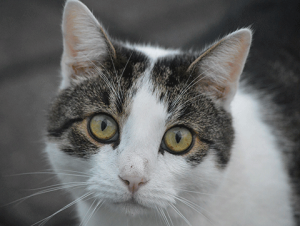It depends on what you mean by “epilepsy” – your cat can have seizures WITHOUT being epileptic! 
What do you mean? Aren’t fits and epilepsy the same thing?
No, there’s an important difference – a fit, or seizure, is the result of abnormal, uncontrolled electrical activity in the cat’s brain (it’s sometimes referred to as an “electrical storm”). Epilepsy technically means ANY disorder resulting in repeated seizures.
However, most people use the word “epilepsy” to refer to “Idiopathic Epilepsy” (IE), a specific disease (complicated, isn’t it?!). This is a fairly well understood genetic disease in dogs (and people) causing epileptic seizures in the absence of any physical disease process – and this does not occur in cats.
Cats can, though, develop “Epilepsy of Unknown Cause” (EUC), which appears similar but does not have a genetic cause and is probably due to microscopic damage to brain tissue (but no-one’s certain if it’s just one disease or several very similar ones). It may occasionally be referred to as “Primary Epilepsy”.
OK, so what DOES cause seizures in cats?
Seizures can be caused by a wide range of different conditions:
Structural Lesions – 47% of seizures in cats are caused by physical damage to the brain tissue, such as:
- Strokes (a bleed or a clot in the brain, starving brain cells of oxygen, typically associated with high blood pressure in older cats)
- Tumours (even benign tumours can cause seizures as they press on the brain tissue)
- Meningitis (caused by infection or an abnormal immune response)
Metabolic Disease – 31% of seizures occur in cats whose brains are basically healthy, but other diseases are affecting the brain’s ability to function normally. Such diseases include:
- Kidney failure (as toxins build up in the body because they aren’t being filtered by the kidneys)
- Liver failure (as ammonium builds up in the blood because the liver isn’t breaking it down)
- Diabetes (abnormally high or low blood sugar levels)
- Poisoning
EUC is responsible for only 22% of cases.
What do seizures in cats look like?
There are two types of seizure in cats:
Generalised seizures are the most obvious, although they are less common. Typically, the symptoms include:
- Initially, changes in behaviour (the Pre-Ictal stage, not shown by all cats)
- Collapse and loss of consciousness
- Violent shaking or convulsions
- Chewing or twitching of the facial muscles
- Salivating
- Loss of bladder and bowel control
- In recovery (the Post-Ictal stage, which may last minutes or hours) the cat is often disorientated, confused or even appears blind
- Full recovery is expected within a few hours
Partial seizures occur when the electrical storm only affects part of the cat’s brain. They are more common than generalised seizures in cats, are very variable in appearance and duration, and are often difficult to recognise. Possible symptoms include:
- Drooling
- Twitching
- Vocalisation
- Abnormal posture
- Abnormal behaviour
How long does a seizure last?
Usually only a couple of minutes – essentially, the brain then realises something’s wrong and “reboots” itself. In cluster seizures, there may be repeated seizures over a few hours or a few days, then a prolonged period without any.
When is a seizure an emergency?
Any cat who suffers a seizure should be checked over by one of our vets. However, if a seizure lasts over five minutes, or two seizures occur without complete recovery in between, your cat needs to be seen right NOW. This may be “Status Epilepticus” which is usually fatal without immediate veterinary treatment.
What can be done about seizures?
In cats, it’s really important to determine the underlying cause if possible. Then treatment can be aimed at managing that condition, preventing further seizures. If this isn‘t possible, there are a range of anti-epileptic drugs that our vets can use (although not as many as for dogs) to reduce the risk and severity of future seizures.
If your cat has had a seizure, make an appointment for them to be checked over by our vets within 24 hours if possible. If they’re still fitting, get them to us NOW.
